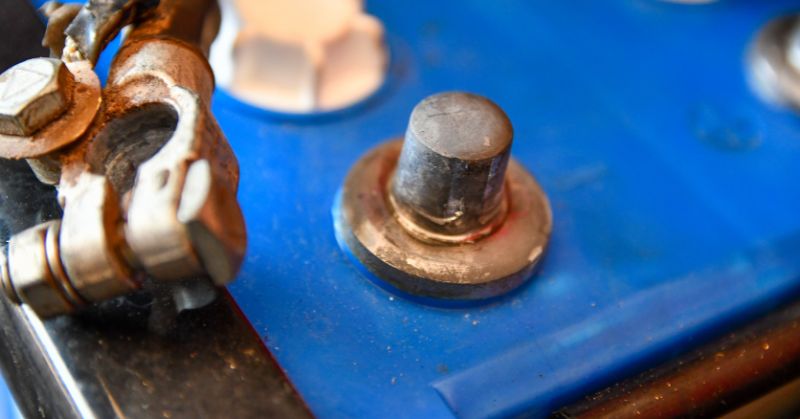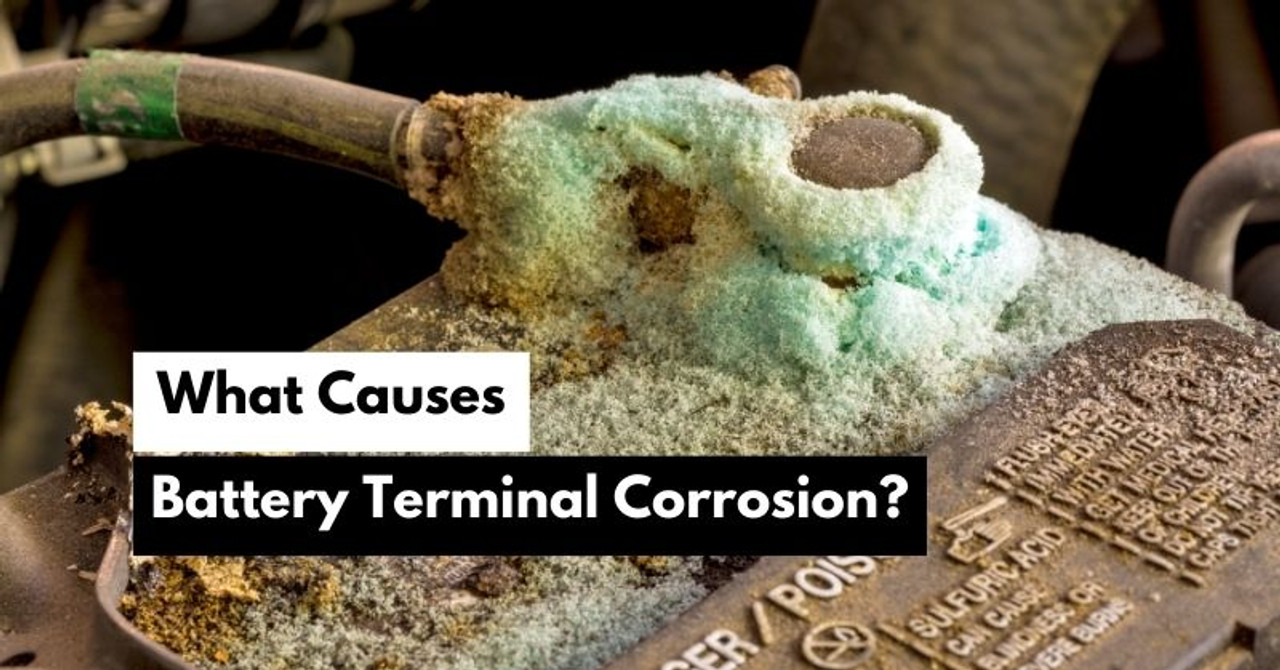What Causes Battery Terminal Corrosion? Key Factors Explained
Corroded battery terminals can be frustrating, as they can create various problems, including but not limited to decreased overall power, battery damage, sparks, damaged cables, and damaged electronics. Have you just lifted your car's hood and found that your battery terminals are corroded? Don't be worried, as you are not alone. Millions of people experience this situation.
Though batteries are one of the most expensive components of electrical and electronic equipment, corrosion on the terminals can reduce the battery life. Therefore, you must be familiar with what causes battery terminal corrosion. Once you know the potential causes, you can perfectly deal with this issue. Don't miss this read, as it explains everything in this regard.
What is battery terminal corrosion?
A specific chemical reaction occurs between salt, moisture, air, and hydrogen gas. As a result, a greenish, bluish, or whitish powdery substance (lead sulfide crystals) surrounds the battery terminals and cables. This is what is known as battery terminal corrosion.
The powdery substance negatively impacts the performance of your battery. A car with a corroded battery can't start properly. Moreover, corrosion greatly reduces your battery life. To extend the life of the battery and make your car start properly, remember to perform regular maintenance and cleaning.

Whether corrosion is blue, white, or green, it harms your car's electrical systems. Therefore, you should clean it on time and avoid it in the future. But before we move toward cleaning or preventing corrosion, let's first explore what causes corrosion on battery terminals.
What causes battery terminal corrosion?
Many factors can cause corrosion on battery terminals, such as overcharging, overfilling, and leaking batteries. Let's explore each reason one by one.
1. Overcharging
When a battery is overcharged, it results in increased temperatures, corrosion, and electrolyte expansion. If you have a flooded lead-acid battery and you overcharge it, the sulfuric acid will boil, causing excessive gas buildup and advanced corrosion on battery terminals. High temperatures overheat the battery, which leads to corrosion.
If you notice that high temperatures and overcharging are the leading reasons behind battery terminal corrosion, don't forget to keep the battery away from extreme heat and follow correct charging practices.
2. Overfilling
When excess water comes into contact with battery terminals and surfaces, corrosion appears. It happens due to a chemical reaction that occurs within the battery. Overfilled batteries may result in an increased risk of battery terminal corrosion, electrolyte dilution, reduced lifespan, and damaged battery cases. If overfilling is the primary reason behind corrosion, ensure you maintain the correct electrolyte levels.
3. Leaking/damaged batteries
Damaged or leaking batteries may result in electrolyte buildup. Age, wear, battery drop, and other physical damages are the potential causes of leaking batteries. To avoid experiencing corrosion on the battery terminal, you should focus on timely replacement and careful handling.
What does battery corrosion look like?
Corrosion on battery terminals appears in different ways. You will mostly see crumbly and flaky material surrounding the terminals. This material can be of different colors, such as brown, gray, green, or blue, as stated earlier. The corrosion color varies depending on the battery type. This is how you can recognize whether or not your battery terminals are corroded.

Moreover, a rotten egg-like smell, difficulty in starting your car, dim lights, and other electrical problems are potential car battery corrosion symptoms. Furthermore, corrosion causes a number of performance-related issues, including but not limited to clicking sound, slow cranking, lack of electric power steering assist, stalling, or weak lights.
How to clean corrosion on battery terminals?
Below is a list of easy-to-follow steps for cleaning corrosion on battery terminals.

Step 1: Ensure safety
Ensuring your safety should be your top priority before you start cleaning corrosion on battery terminals. Corrosion can damage your eyes and skin. Therefore, don't forget to wear premium-quality gloves and goggles to protect your eyes. If the corrosive material gets on your clothes or skin, wash it away immediately.
Step 2: Disconnect the battery
Always disconnect the battery's negative terminal first by carefully releasing the cable and positioning it away. Then, remove the positive terminal of your battery. Using a battery memory saver before removing the terminals can help you protect the electrical system of the car and save stored data. Remember to check the owner's manual for assistance in this regard.
Step 3: Inspect the battery cables
Once the battery terminals are removed, inspect the cables carefully. If the cable insulation is cracking or you see corrosion on the cable where it connects to the battery terminal, it is time to replace the cables on priority.
Step 4: Remove the battery
Once the battery terminals are removed and you have inspected the cables, remove the battery from your car. Though you can clean corrosion while keeping the battery inside the car, taking it out is considered the safest option. When you remove the battery from the car, place it in a shallow pan or bucket and start removing the corrosive material.
Step 5: Start cleaning
Remove corrosion and dust from the battery's surface and terminals with a scrapper or wire brush. Let the corrosive material fall into the pan. In addition, you can easily find the battery terminal cleaner from the local market to remove corrosion. Moreover, a solution of warm water and baking soda also does the perfect job.
Step 6: Dry and reconnect
Remove any coating from the battery terminal with a brush and clean the surface using a microfiber cloth. Then, place the battery back into the car and connect the terminals. This time, connect the positive terminal first.
How to prevent battery terminal corrosion?
Though battery terminal corrosion is normal, you can follow some steps to prevent it from happening again in the future. Below is a list of a few worthy practices.
1. Apply dielectric grease
When you apply dielectric grease and preventive coatings on battery terminals, they don't allow corrosion build-up. Apart from preventing corrosion, these substances increase the battery's lifespan.
Before you proceed, don't forget to use a wire brush to clean the terminals. Then, apply a thin layer of protective coatings and dielectric grease. Keep a close eye on it and reapply as and when needed.
2. Avoid under or overcharging
If the negative terminal of your battery is corroded, it means you are undercharging the battery. It happens when you take many short drives, and the car's electronic devices use a lot of power. On the other hand, if corrosion appears on the positive terminal, it might be an indication of overcharging. A faulty voltage regulator may create this problem. Therefore, you should always follow proper charging practices and use advanced battery chargers to prevent battery terminal corrosion in the future.
3. Regular maintenance
When you keep checking the battery terminals and clean them regularly, you can make sure that the battery performs its functions correctly and lasts longer than normal. Along with regular maintenance, careful inspection for potential leaks or damages is equally important. If you find anything unusual, you should take instant action to prevent further corrosion.
Note: If you need reliable, efficient, lightweight, and long-lasting modern batteries at affordable prices, don't forget to explore the collection available at Renogy.
- Lighter than ever at 55.1 lb.
- Low-temperature protection.
- 31% smaller than other 12V 300Ah LFP batteries.
- Offer 5000+ cycles at 80% DOD.
Conclusion
Overcharging, overfilling, and leaking batteries are the leading causes of corroded battery terminals. Corrosion can be of different colors, such as green, white, blue, and gray. Overcharging produces corrosion on the positive battery terminal, whereas the negative terminal is corroded with undercharging.
If you find corrosion on battery terminals, you can clean it easily with a mixture of baking soda and warm water. Alternatively, you can buy battery terminal cleaner from the market. To prevent corrosion from appearing on the battery terminals in the future, apply a thin layer of preventive coating and dielectric grease. Remember to remove the corrosive material and clean the terminals before you apply the preventive coating. For more details, be sure to read the discussion above.
Frequently asked questions
Does battery terminal corrosion mean the battery is bad?
The corrosion on your battery terminals does not necessarily mean that the battery itself is bad. It can also show that your battery is not functioning properly. However, battery terminal corrosion may cause several issues, including electrical problems, dim lights, reduced lifespan, starting problems, overheating, and more. Similarly, when you use lead-acid batteries for deep cycling, they become prone to corrosion. Remember, corrosion is more common in older batteries or those that are near the end of their lifespan.
Can a bad alternator cause battery corrosion?
Yes, a faulty alternator may result in battery terminal corrosion. It can overcharge your battery, leading to corrosion. Corrosion due to overcharging appears on the positive terminal. Similarly, power may not be redirected to the battery (due to a bad alternator) once the vehicle starts. It may not allow the battery to charge properly. Moreover, if a faulty alternator continues to undercharge or overcharge your battery, it can damage the battery completely. In that case, the only possible solution will be to replace the batteries.
Does corrosion on a car battery mean it needs to be replaced?
In most cases, you can clean the battery terminal corrosion with commercially available battery cleaners or a solution of baking soda and warm water, as discussed above. If corrosion appears on an older battery that has completed its lifespan, you should replace it as soon as possible. Similarly, if the corrosion is severe and has damaged cable connections and terminals, it will not allow the battery to deliver a strong charge. Battery replacement will only be the possible solution in this case.











